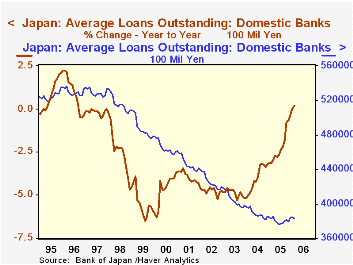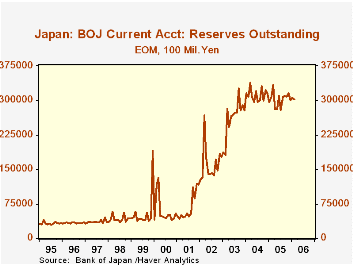 Global| Mar 08 2006
Global| Mar 08 2006Bank Lending "Grows" in Japan; First Time in More Than 9 Years
Summary
The Bank of Japan's Monetary Policy Board is in the midst of a two-day meeting that began Wednesday, March 8 and will conclude Thursday, March 9. It is widely expected that the Bank will initiate a shift away from its nearly five- [...]

The Bank of Japan's Monetary Policy Board is in the midst of a two-day meeting that began Wednesday, March 8 and will conclude Thursday, March 9. It is widely expected that the Bank will initiate a shift away from its nearly five-year-old policy of "quantitative ease", in which it sets a target for the amount of reserves in the banking system, regardless of banks' demands for reserves. In the parlance of US monetary policy, the Japanese central bank has pumped an enormous amount of "excess reserves" into the banks. This target has recently been ¥30-35 trillion each month-end.
In the spring of 2004, this policy began, in an indirect way, to show results. The decline in the banks' loans, which had become quite steep in 1998, started to moderate. Progressively smaller declines have been reported since. Finally, in data released just Wednesday morning Tokyo time, the first dramatic sign of some success appeared through a 0.2% year-on-year increase in bank loans, the first such positive year-on-year figure since September 1996, nearly nine-and-a-half years ago.
The magnitude of the easing strategy can be seen in a ratio of reserves to GDP: 5.3% in 2005, compared with just 0.6% in the mid-1990s. By contrast, in the US, banks' reserves at Federal Reserve Banks have recently been a miniscule 0.4% of GDP, fairly comparable to the historic Japanese amount. More straightforward is a simple comparison of dollar amounts. US reserves at the Fed were about $44.7 billion in February, while Japan's banking system reserves were $260.1 billion, nearly 6 times as much.
Prices have finally stabilized on a year-to-year basis, as we have described here recently for Japan's core CPI, and now bank lending, which underwent a terrible wrenching owing to repeated recessions and the plunge in real estate values, has also finally turned upward, albeit by only a marginal amount.
| JAPAN | Feb 2006 | Jan 2006 | Dec 2005 | Dec 2004 | Dec 2003 | Dec 2002 |
|---|---|---|---|---|---|---|
| Loans at Domestic Banks Mo. Avg, Bil.¥ |
383,337.3 | 384,191.2 | 383,955.8 | 385,178.6 | 298,020.4 | 419,652.9 |
| Yr/Yr % Change | +0.2 | 0.0 | -0.3 | -3.1 | -5.1 | -4.7 |
| BOJ Reserves, EOM, Bil.¥ | 30,240.8 | 30,574.3 | 30,093.8 | 31,466.6 | 27,797.7 | 17,695.6 |
Carol Stone, CBE
AuthorMore in Author Profile »Carol Stone, CBE came to Haver Analytics in 2003 following more than 35 years as a financial market economist at major Wall Street financial institutions, most especially Merrill Lynch and Nomura Securities. She had broad experience in analysis and forecasting of flow-of-funds accounts, the federal budget and Federal Reserve operations. At Nomura Securities, among other duties, she developed various indicator forecasting tools and edited a daily global publication produced in London and New York for readers in Tokyo. At Haver Analytics, Carol was a member of the Research Department, aiding database managers with research and documentation efforts, as well as posting commentary on select economic reports. In addition, she conducted Ways-of-the-World, a blog on economic issues for an Episcopal-Church-affiliated website, The Geranium Farm. During her career, Carol served as an officer of the Money Marketeers and the Downtown Economists Club. She had a PhD from NYU's Stern School of Business. She lived in Brooklyn, New York, and had a weekend home on Long Island.





